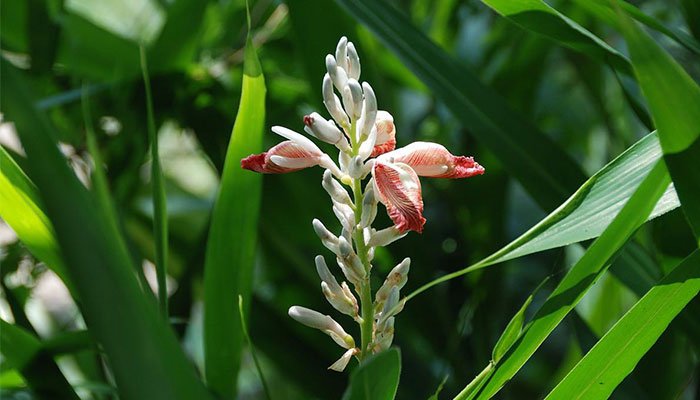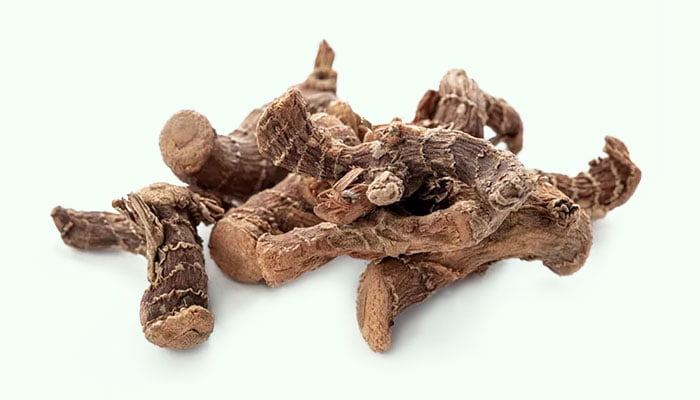What Is Gao Liang Jiang
Gao Liang Jiang commonly known as Rhizoma Alpiniae Officinarum is the rhizome of Alpinia officinarum Hance, which is a perennial herb belonging to the family Zingiberaceae. It is a relatively practical and common Chinese herbal medicine, which first appeared in <Mingyi Bie Lu> around 420-589 AD.
There are about 246 species of Alpinia, which are mainly distributed in tropical and subtropical areas of Asia, Australia, and America. Some of these species are used medicinally, such as Alpinia officinarum Hance, A. oxypnylla Miq., and A. katsumadai Hayata.
Alpinia officinarum Hance is also known as lesser galangal. This plant likes high temperatures and is not hardy. They grow well in well-drained areas. They often grow in hills, hillsides, grass, forest edges, and sparse forests below 700 meters above sea level. They are mainly distributed in China, India, Vietnam, and Cambodia.

In late summer and early autumn, people gather the rhizomes of galangal, remove their fibrous roots and scales, wash them with water, moisten them, cut them into thin slices, dry them in the sun, and make them into Chinese herbal medicines.
Gao Liang Jiang contains chrysin, pinocembrin, tectochrysin, apigenin, galangin, 3-O-methylgalangin, acacetin, kaempferol, kaempferide, quercetin, isorhamnetin, rutin, yakuchinone A, oxyphyllacinol, hexahydrocurcumin, hannokinol, nootkatone, luteolin, izalpinin, β-sitosterol, β-daucosterol, phenylpropanoids, diterpenes, organic acids, and volatile oils.
Generally, the red-brown Gao Liang Jiang with a strong fragrance and a spicy taste is preferred.
According to the Chinese Pharmacopoeia, the medicinal nature of Gao Liang Jiang is relatively hot, with a pungent taste. It has a certain therapeutic effect on the pathological changes of the spleen and stomach meridians.
In traditional Chinese medicine, it is often used to warm middle energizer and arrest vomiting, dispel cold to stop the pain, and treat cold pain in the stomach and abdomen, abdominal distention and pain, toothache, angina pectoris, vomiting, belching, acid regurgitation, pharyngitis, recurrent mouth ulcers, wheezing, chronic obstructive pulmonary disease, reflux esophagitis, and erosive gastritis.
There are more than 150 kinds of traditional Chinese medicine prescriptions containing it, such as Er Jiang Wan, Liang Fu Wan, and Jiu Qi Xin Tong Wan.
Benefits
- Anti-inflammation, inhibiting xylene-induced ear swelling and carrageenan-induced paw swelling in mice.
- Anti-oxidation, scavenging ABTS radicals and reducing ferric ion (Fe3+) to the ferrous ion (Fe2+) [1].
- Increasing the pain threshold and inhibiting the pain caused by the hot plate experiment and acetic acid experiment in mice.
- Warming the spleen and stomach and dispelling cold, treating cold pain in the stomach and abdomen caused by stomach-cold.
- Dispelling cold, regulating stomach to stop vomiting, treating vomiting, belching, and acid regurgitation caused by stomach-cold.
- Galangin improved the learning and memory impairments and hippocampal neuron injury of APP/PS1 mice, which may be related to its regulation of the Akt/MEF2 D/Beclin-1 signaling pathway [2].
- Its hydroalcoholic extract can reduce blood glucose, blood lipid, and liver enzyme levels in nicotinamide/streptozotocin-induced type II diabetic rats [3].
- Its water extract ameliorated the ultraviolet-B-induced photoaging by attenuating the phosphorylation of AKT and ERK [4].
- Its ethyl acetate fraction showed significant cytotoxicity to human hepatoma HepG2, human breast cancer MCF-7, human glioblastoma T98G, and human murine melanoma B16-F10 cell lines [5].
- Its galangal methanol-phase extract can inhibit the growth of Aeromonas hydrophila, Enterobacter sakazakii, Staphylococcus aureus, Vibrio metschnikovii and Vibrio parahaemolyticus [6].
- In vitro and in vivo experiments have confirmed that its total flavonoids can inhibit ethanol-induced gastric mucosal damage [7].
Combinations
- It can be combined with Pao Jiang (Zingiberis Rhizoma Praeparatum) to treat cold pain in the stomach and abdomen caused by stomach-cold.
- It can be combined with Xiang Fu (Rhizoma Cyperi) to treat abdominal distention and pain caused by stomach-cold and stagnation of liver-qi.
- It can be used in combination with Chuan Xiong (Rhizoma Chuanxiong), Dang Gui (Radix Angelicae Sinensis), Rou Gui (Cinnamomi Cortex), etc. to treat angina pectoris, angina abdominis, hypochondrium distention, restlessness, and irritability.
- It can be used in combination with Ban Xia (Pinellia Rhizome), Sheng Jiang (Rhizoma Zingiberis Recens), etc. to treat vomiting, belching, and acid regurgitation caused by stomach-cold.
- It can be used in combination with Dang Shen (Radix Codonopsis), Fu Ling (Poria), Bai Zhu (Rhizoma Atractylodis Macrocephalae), etc. to treat vomiting caused by deficiency-cold.
Side Effects
- Animal studies have shown that Gao Liang Jiang has some toxicity.
Precautions and Warnings
- The dosage of Gao Liang Jiang should be controlled between 3-6g.
- It can be made into decoctions, pills, capsules, medicinal liquors, or grounds for external use.
- People who are allergic to Gao Liang Jiang should not take it.
- It should not be taken at the same time as atropine or senna.
- Patients with syndromes of excess heat should not take it.
- Pregnant and breastfeeding women should take it under medical supervision.
- Children, the elderly, and the infirm should take it under medical supervision.
